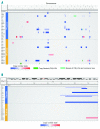Genome analysis of myelodysplastic syndromes among atomic bomb survivors in Nagasaki
- PMID: 31101757
- PMCID: PMC7012461
- DOI: 10.3324/haematol.2019.219386
Genome analysis of myelodysplastic syndromes among atomic bomb survivors in Nagasaki
Abstract
Ionizing radiation is a risk factor for myeloid neoplasms including myelodysplastic syndromes (MDS), and atomic bomb survivors have been shown to have a significantly higher risk of MDS. Our previous analyses demonstrated that MDS among these survivors had a significantly higher frequency of complex karyotypes and structural alterations of chromosomes 3, 8, and 11. However, there was no difference in the median survival time between MDS among survivors compared with those of de novo origin. This suggested that a different pathophysiology may underlie the causative genetic aberrations for those among survivors. In this study, we performed genome analyses of MDS among survivors and found that proximally exposed patients had significantly fewer mutations in genes such as TET2 along the DNA methylation pathways, and they had a significantly higher rate of 11q deletions. Among the genes located in the deleted portion of chromosome 11, alterations of ATM were significantly more frequent in proximally exposed group with mutations identified on the remaining allele in 2 out of 5 cases. TP53, which is frequently mutated in therapy-related myeloid neoplasms, was equally affected between proximally and distally exposed patients. These results suggested that the genetic aberration profiles in MDS among atomic bomb survivors differed from those in therapy-related and de novo origin. Considering the role of ATM in DNA damage response after radiation exposure, further studies are warranted to elucidate how 11q deletion and aberrations of ATM contribute to the pathogenesis of MDS after radiation exposure.
Copyright© 2020 Ferrata Storti Foundation.
Figures






References
Publication types
MeSH terms
LinkOut - more resources
Full Text Sources
Medical
Research Materials
Miscellaneous

